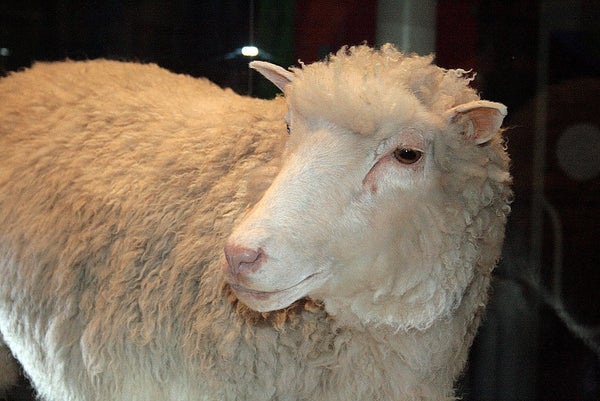This article was published in Scientific American’s former blog network and reflects the views of the author, not necessarily those of Scientific American
Before his 1997 announcement that he’d successfully cloned a sheep named Dolly, Ian Wilmut hired a public relations firm. Wilmut and his colleagues suspected that the idea of cloning a mammal would spark major ethical concerns worldwide, and felt they had to make absolutely clear that that human reproductive cloning was not the goal of their research—that Dolly was cloned for the purely commercial purpose of producing pharmaceuticals in animal milk, at a cost significantly lower than conventional commercial methods. In fact, in their Nature paper describing the experiment, they omitted the words “clone” and “cloning” entirely, using the more obscure and morally neutral “somatic cell nuclear transfer" (SCNT) instead. Indeed, when my colleagues and I published a follow-up paper on Dolly in Nature Genetics in 1999, the journal asked us, too, not to use the loaded term, presumably to avoid raising ethical concerns.
But Wilmut and his colleagues’ precautions did not prevent an onslaught of claims that this technology could be applied to human cloning as well and that it therefore violated several ethical principles. Among the concerns: that cloned mammals had a higher than average risk of health problems; that SCNT created a slippery slope that could ultimately lead to designer babies; and that scientists should not “play God.”
It is no wonder that a 1998 Gallup poll revealed that the public was overwhelmingly against human cloning. Many scientists believe that these ethical concerns prevented Wilmut from receiving the Nobel Prize.
On supporting science journalism
If you're enjoying this article, consider supporting our award-winning journalism by subscribing. By purchasing a subscription you are helping to ensure the future of impactful stories about the discoveries and ideas shaping our world today.
Nevertheless, SCNT research led to many important results. One of the most recent was reported in a groundbreaking 2013 article by Shoukhrat Mitalipov and his colleagues. It described the successful use of in vitro fertilization (IVF) and SCNT technology to transfer genetic material from any non-sperm cell into a human oocyte. The primary objective was to use this technology to generate patient-specific stem cells; it would also allow women with mitochondrial diseases to have healthy children. The way it works: a nucleus is obtained from the egg of a woman with a mutation in her mitochondrial DNA and is transferred into an enucleated egg from a woman with healthy mitochondria. This reconstituted oocyte is then fertilized, via IVF, and implanted into the woman with the mitochondrial mutations to generate a healthy child. Recent studies in the U.K. report this treatment is safe enough to start human trials.
But the same ethical concerns raised by Dolly apply here as well, along with a new one. The technology that can create embryos free of hereditary mitochondrial disease requires that three individuals donate their DNA to the child: the sperm donor, the woman with a genetic mitochondrial disease and the woman who donates healthy mitochondria. This leads two central questions: Does creating embyros from more than two genetic parents violate an ethical principle? And more practically, who are the child’s parents?
Some ethicists believe that because the amount of donated mitochondrial DNA is less than 0.2 percent of the total DNA it can be considered irrelevant in assigning parenthood. But others point to the importance of mitochondrial DNA in embryology, and argue the mDNA donor should share motherhood with the egg donor.
I believe that if this “controversial” mitochondrial replacement technology begins generating healthy children, the ethical dynamics will dramatically shift toward the endorsement of SCNT. Recall the global ethical concerns that emerged in 1978 after the first test-tube baby, Louise Brown, was born and the fear that this technology would be used to create designer babies.
Yet today, over five million babies have since been born using IVF and a majority of the public now supports this technology. Similarly, the public now accepts another IVF based technology—the use of pre-implantation genetic diagnosis in order to select healthy embryos for IVF. History’s lesson is clear: biotechnologies that result in a global medical improvement, such as the generation of healthy children, will readily be accepted by the public and the medical community, despite ethical and even religious concerns, especially as scientists continue improve the safety of SCNT and other technologies.
I predict that when the first healthy baby spared a disabling mitochondrial disease is featured on YouTube, and Facebook, the world will accept this technology, despite ethical concerns. The intense passion and desire of people who want healthy children is an extremely powerful force in overcoming many ethical barriers and challenges in cloning technologies.
